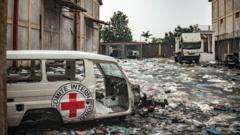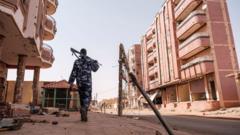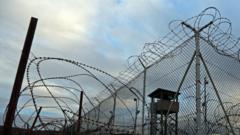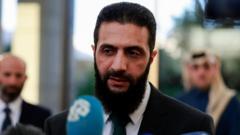In the suburbs of Damascus, the search for mass graves reveals the horrors of Syria's civil war. Civilian remains unearthed by White Helmets humanitarian teams highlight the urgent need for identification and closure for thousands of families enduring the pain of missing loved ones. As international expertise is needed, calls for the protection and investigation of these sites grow stronger.
Unearthing the Forgotten: The Search for Syria's Missing and Mass Graves
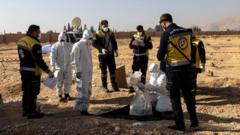
Unearthing the Forgotten: The Search for Syria's Missing and Mass Graves
Humanitarian teams struggle to identify the lost souls buried in mass graves across Syria, confronting the dark legacy of the Assad regime.
In the northwest suburb of Adra, just less than 10km from Damascus's bustling city center, teams from the White Helmets humanitarian organization are tirelessly working to uncover the grim reality of mass graves. This secluded area, sealed off with cement walls, has become the site of somber discovery as rescuers delve into the depths of the past marked by Syria's brutal civil war.
Recent reports and videos circulating online have unveiled the shocking truth about these burial sites where victims of Bashar al-Assad's regime—many who suffered torture in Syria’s infamous prisons—were laid to rest. One such site in Adra yielded a grim find: several large white plastic bags filled with human remains, with a haunting label that read, "Seven bodies, eighth grave, unknown." The team diligently worked to extract the remains, which included skulls and bones, collecting DNA samples essential for future identification.
Ismael Abdullah, a rescuer, conveyed the weight of the responsibility they carry: "Thousands of people are missing. It is going to take time - a lot of it - to get anywhere near the truth about what happened to them." The complexities of the task demand meticulous documentation and forensic evidence collection, areas in which only a few rescuers are trained.
The numbers are staggering; over 100,000 individuals have gone missing in Syria since the onset of conflict in 2011. As the rebel group Hayat Tahrir al-Sham (HTS) takes control, they have begun to open prisons and detention centers, allowing rights groups to estimate that over 80,000 of the missing are presumed dead, and another 60,000 are believed to have been tortured to death, according to the Syrian Observatory for Human Rights (SOHR).
Continuous reports of mass grave locations have emerged, with the Syrian Emergency Task Force (SETF) confirming several more sites. A chilling account from a local resident recounted how security forces would transport bodies in refrigerated containers to Qutayfah, then shred the evidence with bulldozers to obscure the atrocity.
Abdul Kadir al-Sheikha, a local religious leader, recounted his experience being summoned by secret police to preside over a mass burial. He recited prayers as he buried the dead, whom he learned were labeled as terrorists. His account reveals how security forces coveted secrecy, doing everything possible to prevent witnesses to their actions—often barring citizens from observing the burials.
In the wake of the Assad regime's decline, families rushed to prisons and detention centers, seeking answers about their missing loved ones. At one such center, the ground bore witness to scattered IDs of Syrians previously detained, affirming the loss felt by so many. Families, like that of a woman searching for her brother who vanished in 2014, remain in a relentless quest for closure, not willing to abandon hope for the truth.
As the number of missing persons rises and the search for mass graves continues, the overarching challenge remains: the need for international experts to assist in locating, protecting, and identifying buried remains. The voices of the lost demand to be heard amidst the silence of the past—a relentless pursuit for truth in a land haunted by its history.

